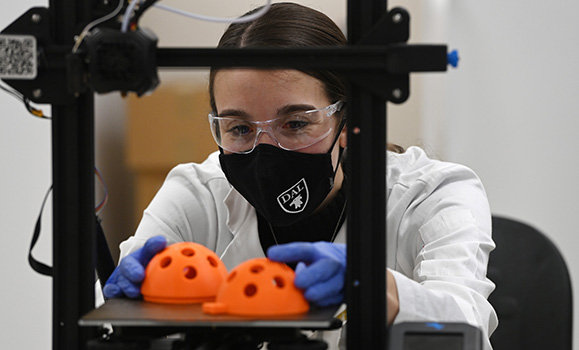When Emalie Hayes and her colleagues began exploring ways to test wastewater for the COVID-19 virus, little did she know that the simple, inexpensive device she developed would end up being used around the world to identify the presence of the pathogen in water systems.
The PhD civil engineering candidate also didn't expect that the 3-D printed, porous ball could be used to detect viruses in freshwater lakes.
But Hayes and Masters student Madison Gouthro have discovered that the adapted passive sampling device can detect a slew of viruses, including SARS-CoV-2, influenza, respiratory syncytial virus, norovirus, adenovirus, enterovirus and rotavirus — all of which were all found in a busy recreational lake in Halifax that is popular with swimmers and boaters.

PhD student Emalie Hayes inspects a 3-D printed ball used in water testing. (Danny Abriel photo)
The pair deployed the spherical cages, fitted with granular activated carbon (GAC) to act as the collection medium, in the healthy lake over three months last year to see if they would detect eight specific viruses.
They were surprised by the results: the devices registered all seven viruses, with adenovirus being the most prevalent.
"This initial work shows that we can detect these viruses, so we think the future research opportunities could be exciting and set the tone for research possibilities that are profound for understanding viruses in our water," says Hayes.
"As we continue to optimize, we could in the long run help improve the information we provide to public health agencies. And this could be useful for many sources in addition to freshwater, like groundwater systems and untreated water supplies. It's exciting."
How'd the viruses get there?
Samples were collected from two locations in the lake, located in an urban area surrounded by residential and commercial properties, recreational canoe and kayak facilities, and several roads. There are no known wastewater inputs to the lake. The passive samplers were deployed from a floating dock next to a popular beach and in another site near the water’s edge for a week at a time. They were then replaced with new ones while the GAC was tested for the viruses, using the same QPCR detection strategy as a COVID test.
The team also did grab samples of water from the same sites to see if they captured the same viruses, finding that the passive sampler had a much higher detection rate for all viruses.
Gouthro, who has deployed the samplers and analyzed many of the samplers as part of her graduate research, said it is not yet clear how the viruses made their way into the lake, but it could be sourced to direct human input from recreational use, runoff from rain events or subsurface discharge from septic systems.
"That is a big question that we're trying to look into. We're not entirely sure right now, but there are many mechanisms that they may be entering the water system," she said. "This is such a great learning experience. And it feels like we're contributing to a community that we've been a part of for so many years."
Human viruses can pose serious health risks in freshwater environments like lakes, yet it can be difficult to detect their presence and abundance since current methods are limited, time-intensive and costly. It is not clear what the implications are for human health when it comes to these viruses, but some can be linked to water-related gastrointestinal illness.
It's estimated that most human viruses — upwards of 85 per cent — are known to be non-enteric, like SARS-CoV-2 and influenza which do not reside or replicate in the intestine.

A sign explains the algae and virus detection project to lake-goers.
Transforming how we track viruses
The COVID-19 pandemic illustrated the importance of non-enteric viral tracking in water environments, particularly wastewater effluents, to understand respiratory viruses' fate, transport and infectivity in environmental reservoirs.
"This research outcome has potential to transform viral monitoring programs for recreational and drinking water sources. Viruses are now non-detected or simply not measured in lakes and rivers because of inadequate sampling and detection protocols," says Dr. Graham Gagnon, director of the Centre for Water Resource Studies (CWRS) at Dal.
"Our team was able to detect RSV, influenza and SARS-CoV-2 at levels that were not previously detected. I am hopeful with this work the community can better understand the occurrence of these viruses, which will ultimately lead to an improved evaluation of sources and impact."
The researchers, who recently published their findings in , say they are continuing to monitor area lakes and improve their detection methodology.
The innovative project is being followed closely by municipal officials.
"We look forward to better understanding the implications of this research on recreational water quality and recreational water activities in the lake," says Emma Wattie, manager of Environment at Halifax Regional Municipality.
"We’re looking forward to learning more about the impacts on how we track the movement of viruses through the environment."
Recommended reading:ÌýWhat's in the water? Dal expands water surveillance projects with new funding

